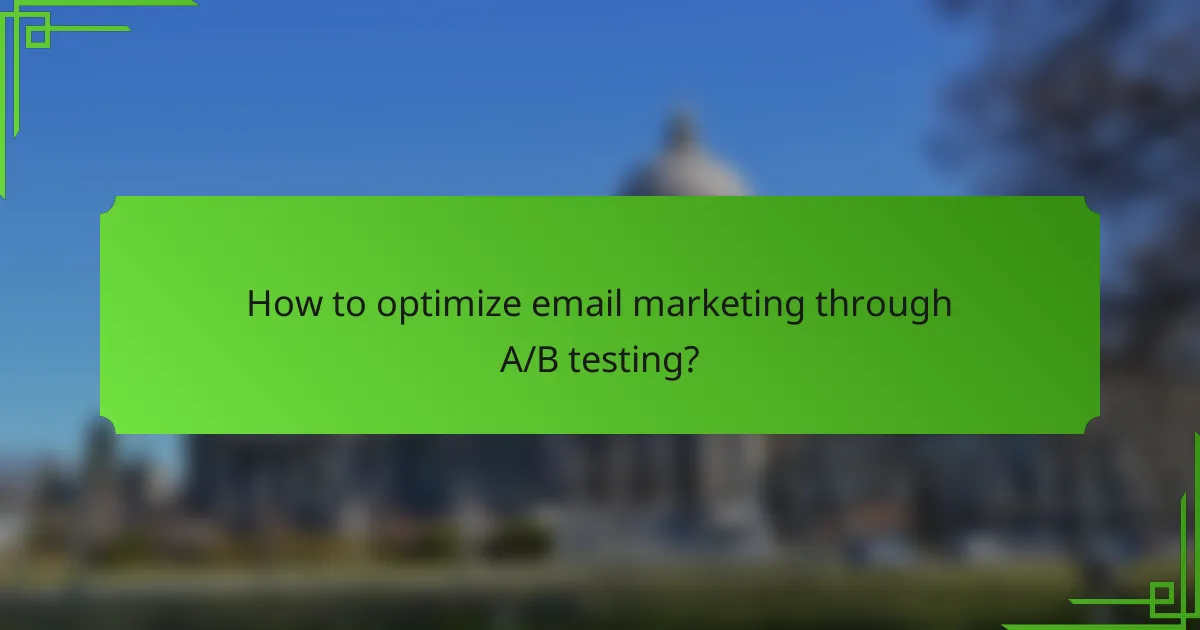Email marketing optimization through A/B testing is a crucial strategy for enhancing campaign performance. By comparing different versions of emails, marketers can identify which elements resonate best with their audience, leading to improved engagement and conversion rates. Implementing best practices, such as testing one variable at a time and using control groups, ensures reliable results that drive data-informed decisions.

How to optimize email marketing through A/B testing?
Optimizing email marketing through A/B testing involves comparing two versions of an email to determine which performs better based on specific metrics. This process helps refine email campaigns, leading to improved engagement and conversion rates.
Identify key metrics for testing
Key metrics for A/B testing in email marketing include open rates, click-through rates, conversion rates, and unsubscribe rates. Focus on metrics that align with your campaign goals, such as increasing sales or enhancing user engagement.
For example, if your goal is to boost sales, prioritize conversion rates and revenue generated from each email variant. Tracking these metrics will provide a clear picture of which version resonates more with your audience.
Segment your audience effectively
Effective audience segmentation allows you to tailor your A/B tests to specific groups, increasing the relevance of your emails. Consider factors such as demographics, purchase history, and engagement levels when segmenting your audience.
For instance, you might test different subject lines on a segment of first-time buyers versus repeat customers. This approach ensures that the insights gained are applicable to the right audience, enhancing overall campaign effectiveness.
Choose elements to test
Select specific elements of your email to test, such as subject lines, call-to-action buttons, images, or email layouts. Testing one element at a time helps isolate its impact on performance, making it easier to draw conclusions.
A common practice is to test subject lines by varying their length or tone. For example, compare a straightforward subject line against a more playful one to see which garners higher open rates.
Analyze results for actionable insights
After running your A/B tests, analyze the results to extract actionable insights. Look for statistically significant differences in performance metrics to determine the winning variant.
Utilize tools that can help visualize the data, such as graphs or tables, to make comparisons clearer. Document your findings and apply the insights to future campaigns to continuously improve your email marketing strategy.

What are the best practices for A/B testing in email marketing?
The best practices for A/B testing in email marketing involve systematic approaches that enhance the effectiveness of your email campaigns. Key strategies include using a control group for comparison, testing one variable at a time, and ensuring tests run for a sufficient duration to gather reliable data.
Use a control group for comparison
A control group is essential in A/B testing as it provides a baseline to measure the impact of changes. By comparing the performance of your test group against the control group, you can determine whether the modifications made lead to significant improvements in metrics such as open rates or click-through rates.
For instance, if you send one version of an email to 1,000 subscribers and a different version to another 1,000, the latter group serves as your control. This setup allows you to assess the effectiveness of your changes accurately.
Test one variable at a time
Focusing on a single variable during A/B testing helps isolate the effects of that change. Whether you are testing subject lines, images, or call-to-action buttons, altering multiple elements simultaneously can obscure results and make it difficult to identify what drove any observed differences.
For example, if you change both the subject line and the layout of an email, you won’t know which change influenced the response. Stick to one variable per test to ensure clarity in your findings.
Run tests for sufficient duration
Running A/B tests for an adequate duration is crucial to gather enough data for reliable conclusions. Depending on your email frequency and audience size, tests should typically last from a few days to a couple of weeks to account for variations in subscriber behavior.
A common guideline is to allow tests to run until you achieve a statistically significant sample size, which can often mean waiting until you have several hundred responses. This timeframe helps mitigate the impact of anomalies and seasonal trends on your results.

How can A/B testing improve email open rates?
A/B testing can significantly enhance email open rates by allowing marketers to compare different versions of their emails to see which performs better. By systematically testing elements like subject lines and content, businesses can make data-driven decisions that lead to higher engagement.
Optimize subject lines
Subject lines are crucial for capturing attention in crowded inboxes. A/B testing different subject lines can reveal which phrases resonate more with your audience. For example, testing a question versus a statement can provide insights into what prompts more opens.
Consider using action-oriented language or personalization in your subject lines. A simple change, such as including the recipient’s name or a relevant offer, can increase open rates by several percentage points. Aim for subject lines that are concise, ideally under 50 characters, to ensure they display well on mobile devices.
Personalize email content
Personalization in email content can significantly boost engagement and open rates. A/B testing allows you to experiment with different levels of personalization, such as using the recipient’s name or tailoring content based on previous interactions. This approach makes emails feel more relevant and engaging.
Utilize segmentation to send targeted emails based on user behavior or demographics. For instance, you might test different messages for new subscribers versus long-term customers. Aim for a balance between personalization and maintaining a scalable approach to avoid overwhelming your resources.

What tools can enhance A/B testing for email campaigns?
Several tools can significantly improve A/B testing for email campaigns by providing insights, analytics, and advanced testing capabilities. Utilizing these tools can help marketers optimize their email strategies and achieve better engagement rates.
Mailchimp for A/B testing
Mailchimp offers a user-friendly platform for A/B testing, allowing users to test different subject lines, content layouts, and send times. You can easily set up tests by selecting your audience and defining the variations you want to compare.
With Mailchimp, you can analyze the performance of each variant based on metrics such as open rates and click-through rates. This data helps in making informed decisions about which email elements resonate best with your audience.
HubSpot for analytics
HubSpot provides robust analytics tools that track the performance of your A/B tests in detail. You can view metrics like conversion rates, engagement levels, and revenue generated from each email variant.
Using HubSpot’s reporting features, you can segment your audience and tailor your tests to specific demographics. This targeted approach can lead to more effective campaigns and higher ROI.
Optimizely for advanced testing
Optimizely is known for its advanced testing capabilities, allowing for more complex A/B tests beyond simple email variations. It supports multivariate testing, enabling marketers to experiment with multiple elements simultaneously.
This tool is ideal for businesses looking to deeply understand user behavior and preferences. By leveraging Optimizely’s insights, you can refine your email strategies and enhance overall campaign performance.

What are the common mistakes in email A/B testing?
Common mistakes in email A/B testing can significantly skew results and lead to ineffective strategies. Key errors include testing too many variables at once and ignoring the importance of statistical significance in your findings.
Testing too many variables
Testing multiple variables simultaneously can complicate the analysis and dilute the impact of individual changes. For instance, if you alter the subject line, call-to-action, and layout in one test, it becomes challenging to determine which element influenced the results.
A better approach is to focus on one variable at a time. This allows for clearer insights and more actionable data. For example, if you first test the subject line and then the call-to-action, you can pinpoint which change drove higher engagement.
Ignoring statistical significance
Ignoring statistical significance can lead to misinterpretation of A/B test results. Without proper analysis, you might mistakenly conclude that a change is effective when it is simply due to random chance. Aim for a confidence level of at least 95% to ensure your findings are reliable.
To avoid this pitfall, use tools that calculate statistical significance automatically. These tools can help you determine whether the differences in performance metrics are meaningful or merely coincidental, guiding you to make informed decisions based on solid data.

How to measure the success of email marketing campaigns?
Measuring the success of email marketing campaigns involves analyzing various metrics that indicate how well your emails perform. Key performance indicators (KPIs) such as open rates, click-through rates, and conversion rates provide insights into engagement and effectiveness.
Track conversion rates
Conversion rates reflect the percentage of recipients who complete a desired action after engaging with your email, such as making a purchase or signing up for a newsletter. To calculate this, divide the number of conversions by the total number of emails delivered, then multiply by 100 to get a percentage.
For example, if you sent 1,000 emails and 50 recipients made a purchase, your conversion rate would be 5%. Monitoring this metric helps you understand the effectiveness of your email content and call-to-action.
To improve conversion rates, consider A/B testing different subject lines, email designs, and offers. Avoid common pitfalls such as unclear calls-to-action or overly complex landing pages, as these can hinder conversions.